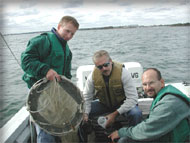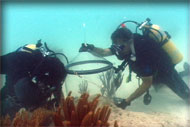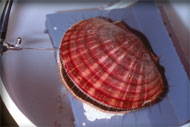Research Initiatives
I am an experim ental biologist whose research interests are directed toward an understanding of the dynamic interactions between marine animals and their environment. In particular, my work focuses on the endogenous and exogenous factors that mediate the behavior and physiology of benthic, particle-feeding invertebrates. I take an integrative approach in my research program by studying processes ranging from the organism to ecosystem level. Much of my research focuses on commercially important species, or shellfish (e.g., clams, oysters, mussels, scallops). These animals exert great control over the particle supply and distribution in many coastal ecosystems, can influence the biology and ecology of other organisms, and provide vital ecosystem services. Because suspension feeders play such a key role in near-shore ecosystems, it is important to understand how they obtain and process food and non-food particles, what factors control feeding processes, and the effects of environmental perturbations on their overall health. Our work is funded by grants from the National Science Foundation, National Oceanographic & Atmospheric Administration (Marine Debris & CT Sea Grant), and US Department of Agriculture.
ental biologist whose research interests are directed toward an understanding of the dynamic interactions between marine animals and their environment. In particular, my work focuses on the endogenous and exogenous factors that mediate the behavior and physiology of benthic, particle-feeding invertebrates. I take an integrative approach in my research program by studying processes ranging from the organism to ecosystem level. Much of my research focuses on commercially important species, or shellfish (e.g., clams, oysters, mussels, scallops). These animals exert great control over the particle supply and distribution in many coastal ecosystems, can influence the biology and ecology of other organisms, and provide vital ecosystem services. Because suspension feeders play such a key role in near-shore ecosystems, it is important to understand how they obtain and process food and non-food particles, what factors control feeding processes, and the effects of environmental perturbations on their overall health. Our work is funded by grants from the National Science Foundation, National Oceanographic & Atmospheric Administration (Marine Debris & CT Sea Grant), and US Department of Agriculture.
I. Interactions Between Marine Aggregates and Benthic Suspension Feeders: Living and non-living particulate matter is ubiquitous in aquatic systems. Through physical, chemical and biological interactions, this material aggregates into larger particle masses (marine snow, flocs). Aggregation of particles has been recognized as an important mechanism for the transport of carbon, nutrients, and other materials to the benthos. Our work on the interaction of aggregates and suspension feeders can be divided into two areas of focus.
- Aggregates, TEP and benthic pelagic coupling – The traditional concept of benthic-pelagic coupling by suspension feeders involves the removal of phytoplankton and other particles from the water column, deposition of feces and pseudofeces to the bottom, and conversion of food material f
 or animal production. We have described another possible mechanism by which suspension feeders can couple the benthic and pelagic realms: 1) the pumping of water over feeding structures releases large quantities of transparent exopolymer particles (TEP); 2) the released TEP enhances particle aggregation and, consequently, deposition of material to the benthos; and 3) the aggregates and their constituent particles can be ingested.
or animal production. We have described another possible mechanism by which suspension feeders can couple the benthic and pelagic realms: 1) the pumping of water over feeding structures releases large quantities of transparent exopolymer particles (TEP); 2) the released TEP enhances particle aggregation and, consequently, deposition of material to the benthos; and 3) the aggregates and their constituent particles can be ingested. - The aggregate pathway and enhanced uptake of nanomaterials (an Oceans and Human Health Linkage) – Manufactured nanoparticles and nanotubes are at the forefront of nanotechnology and are being used in a variety of applications including cosmetics, electronics, drug delivery, manufacturing technologies, molecular biology, and paints. The way in which nanoparticles are taken up by aquatic organisms, however, has been little studied. In this project, we are considering how feeding limitations of several bivalve species affect their uptake of nanoparticles, and determining how the form of delivery (freely suspended or incorporated in aggregates) mediates bioavailability, retention, and thus internal exposure. This work is being conducted in collaboration with Rob Mason (Department of Marine Sciences).
II. Feeding Behavior and Physiology of Suspension Feeders: In this line of research, my students and I are addressing fundamental questions regarding suspension feeding mechanisms. We are investigating the plasticity of particle capture in two groups of invertebrate suspension-feeders (bivalves, tunicates) to determine if particle capture responds to changes in the number and types of planktonic cells available (i.e., plasticity), or if capture is a consequence of the physicochemical properties of the cells (e.g., size, shape, surface charge, wettability). The combined application of in situ and laboratory studies will allow us to examine, with unprecedented accuracy and resolution, the full range of planktonic cells that suspension feeders capture, and address fundamental questions regarding physiological control of particle capture (or lack thereof) under different particle spectra (i.e., changing food supplies). Results of the study will enable us to better predict the types of plankton that are and are not captured efficiently, provide insight into the factors influencing mechanisms of particle capture, and strengthen existing models regarding interspecific competition and impacts of S-F on microbial community structure of the seston. This work is being conducted in collaboration with Israeli and Canadian scientists.
fundamental questions regarding suspension feeding mechanisms. We are investigating the plasticity of particle capture in two groups of invertebrate suspension-feeders (bivalves, tunicates) to determine if particle capture responds to changes in the number and types of planktonic cells available (i.e., plasticity), or if capture is a consequence of the physicochemical properties of the cells (e.g., size, shape, surface charge, wettability). The combined application of in situ and laboratory studies will allow us to examine, with unprecedented accuracy and resolution, the full range of planktonic cells that suspension feeders capture, and address fundamental questions regarding physiological control of particle capture (or lack thereof) under different particle spectra (i.e., changing food supplies). Results of the study will enable us to better predict the types of plankton that are and are not captured efficiently, provide insight into the factors influencing mechanisms of particle capture, and strengthen existing models regarding interspecific competition and impacts of S-F on microbial community structure of the seston. This work is being conducted in collaboration with Israeli and Canadian scientists.
III. Ingestion and Egestion of Microplastics by Bivalves: Plastics (synthetic poly mers) are one of the most common and persistent pollutants in marine waters worldwide. Weathering of macroplastic materials results in the release of microplastics, the environmental damage of which is largely unknown. In this research, field studies are quantifying the types and quantities of plastic particles found in bivalves growing in natural populations and aquaculture farms. Under controlled laboratory conditions, bivalves are being exposed to several types of microplastics with different physicochemical characteristics (i.e., size, shape, aspect ratio, surface charge, surface wettability), and the most frequently ingested and most frequently rejected types are being determined. With these data we are developing a model that can predict, based on the physicochemical properties of the plastic particles, which types are likely taken up by the bivalves. This research is being conducted in collaboration with Sandra Shumway (Department of Marine Sciences), and Kevin Brown (Oregon State University).
mers) are one of the most common and persistent pollutants in marine waters worldwide. Weathering of macroplastic materials results in the release of microplastics, the environmental damage of which is largely unknown. In this research, field studies are quantifying the types and quantities of plastic particles found in bivalves growing in natural populations and aquaculture farms. Under controlled laboratory conditions, bivalves are being exposed to several types of microplastics with different physicochemical characteristics (i.e., size, shape, aspect ratio, surface charge, surface wettability), and the most frequently ingested and most frequently rejected types are being determined. With these data we are developing a model that can predict, based on the physicochemical properties of the plastic particles, which types are likely taken up by the bivalves. This research is being conducted in collaboration with Sandra Shumway (Department of Marine Sciences), and Kevin Brown (Oregon State University).
IV. Interactions between Benthic Suspension Feeders and their Microbial Communities: Prokaryotic organism s are ubiquitous and essential to all habitats on Earth. Within the marine environment, bacteria sustain the base of food webs, drive a manifold of biogeochemical processes and through symbioses, influence the evolution of multicellular life. Although bivalves are important members of coastal ecosystems and have commercial value, their microbiomes remain largely unexplored. In this project, we are investigating the genetic and functional diversity of the bivalve-associated microbiome to understand its involvement in host physiological processes. We are interested in the role of gut and gill microbiota in bivalve toxicology, specifically involving anthropogenic pollutants like microplastics, nanoparticles, and pesticides. We utilize traditional bivalve husbandry and toxicological methods along with high-throughput sequencing and culture-based microbial techniques to conduct this research.
s are ubiquitous and essential to all habitats on Earth. Within the marine environment, bacteria sustain the base of food webs, drive a manifold of biogeochemical processes and through symbioses, influence the evolution of multicellular life. Although bivalves are important members of coastal ecosystems and have commercial value, their microbiomes remain largely unexplored. In this project, we are investigating the genetic and functional diversity of the bivalve-associated microbiome to understand its involvement in host physiological processes. We are interested in the role of gut and gill microbiota in bivalve toxicology, specifically involving anthropogenic pollutants like microplastics, nanoparticles, and pesticides. We utilize traditional bivalve husbandry and toxicological methods along with high-throughput sequencing and culture-based microbial techniques to conduct this research.